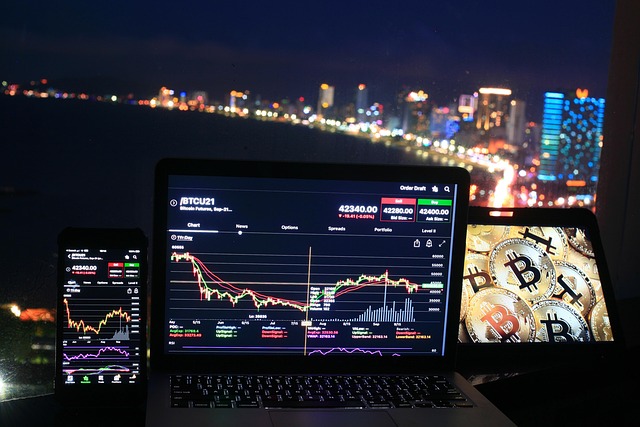What Is Leverage in Futures Trading Crypto in 2025: Comprehensive Guide for Traders
Author: Jameson Richman Expert
Published On: 2025-10-08
Prepared by Jameson Richman and our team of experts with over a decade of experience in cryptocurrency and digital asset analysis. Learn more about us.
Leverage in crypto futures trading has become an indispensable tool for traders aiming to amplify their market exposure, optimize capital efficiency, and execute sophisticated trading strategies in a rapidly evolving digital asset landscape. As we approach 2025, understanding the nuanced mechanics of leverage—its operational principles, strategic applications, regulatory environment, and risk management—is critical for both novice and professional traders seeking consistent profitability and risk mitigation. This comprehensive guide delves deep into leverage’s role within the crypto futures ecosystem, equipping traders with detailed insights to navigate high-stakes environments confidently and responsibly.

Understanding Futures Trading in Cryptocurrency: Foundations, Significance, and Evolution in 2025
Crypto futures trading involves entering into standardized derivative contracts that obligate either party to buy or sell a specific quantity of cryptocurrency at a predetermined price on a future date. These contracts enable traders to speculate on price movements, hedge existing positions, and employ arbitrage strategies without the need to hold the underlying assets physically. By 2025, the landscape of crypto futures has undergone transformative growth, driven by increased institutional participation, advancements in decentralized finance (DeFi), and seamless interoperability across blockchain ecosystems. These developments have elevated futures trading from a niche activity to a core component of modern crypto portfolio management and institutional hedging strategies.
The evolution of crypto futures in 2025 is characterized by AI-powered predictive analytics, enhanced risk management protocols, and regulatory frameworks aimed at transparency and investor protection. These advancements foster market stability, reduce systemic risks, and bolster investor confidence, with futures now serving not only speculative purposes but also strategic operational functions such as hedging against volatility, arbitrage, and providing liquidity. Consequently, futures trading has become an integral part of diversified, risk-adjusted crypto investment portfolios.
Deep Dive into Leverage in Cryptocurrency Futures: Differentiation from Traditional Markets
Leverage in crypto futures allows traders to control positions significantly larger than their available capital by borrowing funds from the trading platform or through decentralized mechanisms. This capacity to leverage is generally higher than in traditional financial markets—where leverage is often capped at 2x to 5x due to regulatory restrictions—thanks to the borderless, decentralized nature of digital assets and the comparatively nascent regulatory oversight. Crypto exchanges frequently offer leverage exceeding 100x, which can exponentially magnify both gains and losses, making leverage a potent yet risky tool.
For instance, employing 50x leverage means that a 2% favorable price movement in the underlying asset could theoretically double the initial margin as profit, whereas a 2% adverse move could wipe out the entire margin and lead to liquidation. The 24/7 trading cycle, combined with extreme volatility—where daily swings of 10% or more are commonplace—necessitates meticulous leverage management, real-time risk monitoring, and disciplined position sizing for traders to survive and thrive in this environment.
Operational Mechanics of Leverage in Crypto Futures: Margin, Liquidation, and Risk Dynamics
Leverage’s functional architecture hinges on several critical concepts:
- Initial Margin: The collateral deposit required to open a leveraged position. For example, at 20x leverage, depositing just 5% of the total position value secures the trade, acting as security against potential losses. This initial margin varies depending on the platform, asset volatility, and leverage level.
- Maintenance Margin: The minimum equity threshold that must be maintained to keep a position alive. If market fluctuations cause the account equity to fall below this threshold, the trader receives a margin call or the position is automatically liquidated to prevent negative balances. Maintenance margins are often dynamically adjusted based on current market volatility and leverage levels.
- Liquidation Process: When market movements cause the account’s equity to drop below the maintenance margin, the platform executes an automatic closure of the position. Due to crypto markets’ high volatility, this process can occur within seconds, emphasizing the importance of real-time risk management tools and pre-set stop-loss orders.
In 2025, many platforms incorporate AI-driven risk analytics, real-time alerts, and predictive modeling to help traders preemptively adjust leverage levels, minimizing the risk of forced liquidation during volatile periods. These technological tools are vital for managing the heightened risks inherent in leverage-heavy crypto futures trading.

Leveraging Dual Edges: Maximizing Gains Versus Managing Elevated Risks
Advantages of Leverage in Crypto Futures
- Amplified Gains: High leverage facilitates capturing small price movements, exponentially increasing potential profits with relatively low capital outlay—crucial in the volatile crypto environment of 2025.
- Efficient Capital Deployment: Leverage frees up capital, allowing traders to diversify their portfolios, execute multiple strategies, and capitalize on various market conditions simultaneously—especially valuable amid rapid market shifts.
- Enhanced Trading Flexibility: Supports high-frequency, scalping, and day trading techniques, which are prevalent in 2025’s fast-paced crypto markets, enabling traders to respond swiftly to market signals.
Risks and Mitigation Strategies
Despite these advantages, high leverage magnifies market risks, especially given crypto’s notorious volatility. Effective risk mitigation is essential to prevent catastrophic losses:
- Automated Stop-Loss and Take-Profit Orders: Use of AI-enhanced, adaptive orders that respond to market volatility, automatically closing positions at predefined thresholds to safeguard capital.
- Position and Trade Sizing: Employing disciplined sizing strategies to avoid overleveraging, aligning position sizes with risk appetite and available capital.
- Dynamic Risk Monitoring: Leveraging big data analytics, machine learning, and real-time data feeds to continuously assess risk exposure and adjust leverage levels proactively.
- Platform and Regional Regulations: Adhering to platform-imposed leverage caps and regional legal standards to prevent forced liquidations and comply with legal frameworks.
Global and Regional Regulatory Environment for Crypto Leverage in 2025
The regulatory environment surrounding crypto leverage continues to evolve, emphasizing consumer protection and systemic stability. Key regional developments include:
- European Union: The Markets in Crypto-Assets (MiCA) regulation introduces standardized leverage limits, mandatory disclosure requirements, and enhanced platform transparency. MiCA aims to harmonize regulatory standards across member states, fostering safer and more transparent trading environments.
- United States: The SEC and CFTC enforce strict oversight of derivatives markets, often capping leverage at 2x to 20x depending on trader profiles, with ongoing updates to regulations prioritizing investor protection and systemic risk reduction.
- Asia: Countries such as Singapore, Japan, and South Korea impose leverage restrictions and strict KYC/AML procedures. Many platforms implement tiered leverage models that grant higher leverage to verified, low-risk traders, balancing opportunity with safety.
Compliance with these regulations influences platform choice, trading strategies, and risk management practices, making regulatory awareness a cornerstone of successful crypto futures trading in 2025.
Top Platforms Providing Leverage in Crypto Futures Trading in 2025
- Binance: Offers up to 125x leverage on select markets, equipped with advanced risk management, a range of order types, and an intuitive interface. Register here
- Mexc: Leverage up to 20x, with innovative features such as multi-asset trading, high liquidity, and user-friendly design. Join Mexc
- Bitget: Known for social trading, copy trading, and leverage options up to 100x, with robust risk controls and community engagement. Register on Bitget
- Bybit: Focuses on user-friendly UI, comprehensive risk management tools, and leverage up to 100x. Join Bybit

Determining the Optimal Leverage: Tailored Strategies for Different Trader Profiles
- Beginner Traders: Recommended leverage levels are conservative—2x to 3x—to facilitate learning, minimize risk, and build confidence. Use demo accounts, educational resources, and gradual exposure to leverage.
- Intermediate Traders: Can utilize 5x to 10x leverage, combining technical analysis, diversified holdings, and disciplined risk controls to enhance gains while maintaining manageable exposure.
- Professional and Algorithmic Traders: Employ higher leverage—sometimes exceeding 20x—paired with algorithmic trading, AI analytics, and hedging strategies to maximize performance and mitigate risks.
Advanced Risk Management Techniques for 2025’s Leverage-Heavy Crypto Futures Market
Sustainable profitability in leverage-intensive trading requires advanced strategies:
- Automated Dynamic Stop-Loss & Take-Profit Orders: Deploy AI-powered, adaptive orders that respond to volatility, reducing emotional reactions and safeguarding capital during sudden market moves.
- Real-Time Portfolio and Risk Analytics: Utilize big data, machine learning, and real-time dashboards to assess risk metrics continuously and adapt strategies instantly.
- Portfolio Diversification and Position Scaling: Spread risk across multiple assets and leverage levels, avoiding over-concentration and reducing systemic exposure.
- Regulatory Compliance: Enforce platform leverage caps and regional legal standards diligently to prevent forced liquidations and legal issues.
The Future of Leverage in Crypto Futures: Trends and Innovations Beyond 2025
The future of leverage in crypto futures points toward greater transparency, automation, and decentralized solutions. AI-driven predictive analytics and automated hedging will enable traders to manage leverage proactively, while decentralized exchanges (DEXs) could introduce non-custodial leverage pools that enhance security and user sovereignty. Regulatory frameworks are expected to tighten leverage caps globally, promoting safer trading environments. Continuous technological innovation, including blockchain-based risk sharing, tokenized collateral pools, and AI-enhanced risk controls, will shape the next generation of leveraged crypto trading. Staying adaptive and informed will be essential for traders seeking to capitalize on these advancements beyond 2025.

Conclusion: Strategically Mastering Leverage for Sustainable Crypto Futures Trading in 2025
Leverage remains a powerful yet complex component of crypto futures trading, offering significant profit opportunities when employed judiciously. As 2025 approaches, the convergence of stricter regulations, technological advancements, and heightened market volatility necessitates disciplined, informed trading practices. Successful traders will leverage advanced risk management tools, adhere to regulatory standards, and pursue continuous education to navigate this high-stakes environment effectively. With platforms like Binance, Mexc, Bitget, and Bybit leading the way, responsible leverage usage can foster sustainable growth, long-term profitability, and resilience in the dynamic crypto futures landscape beyond 2025.